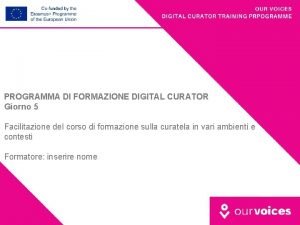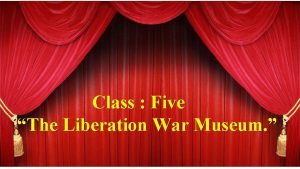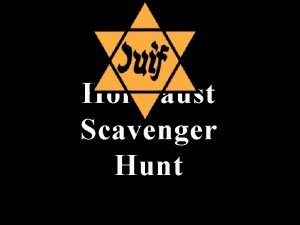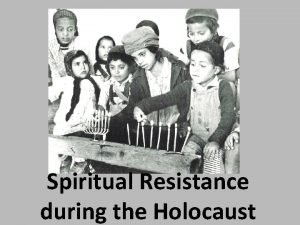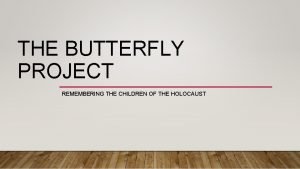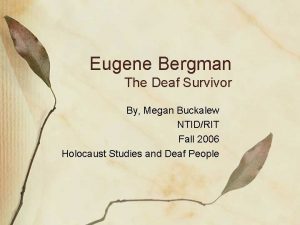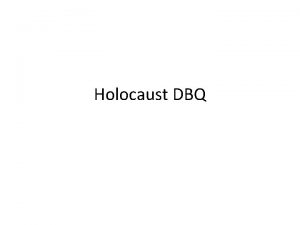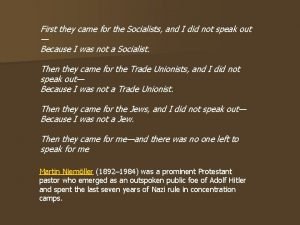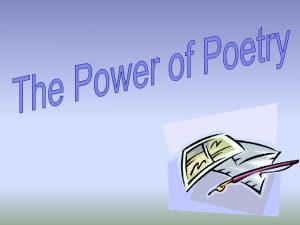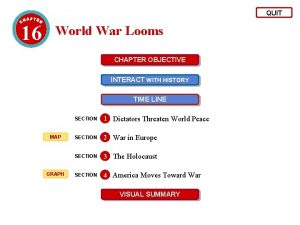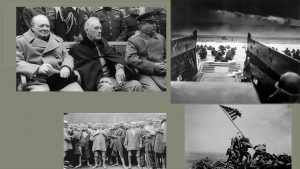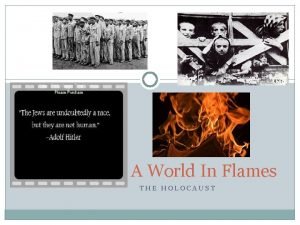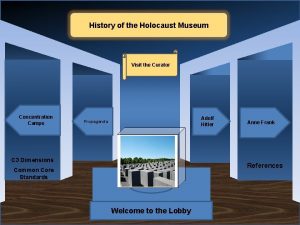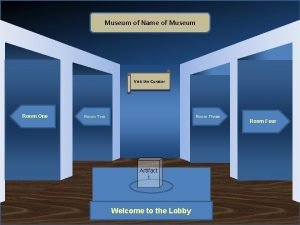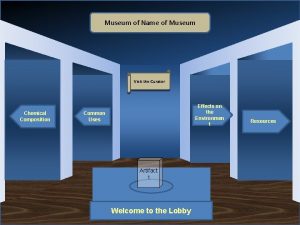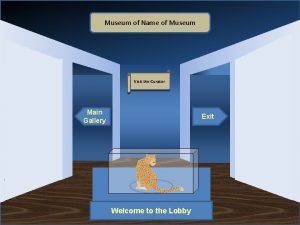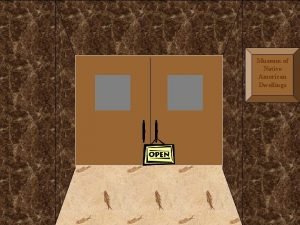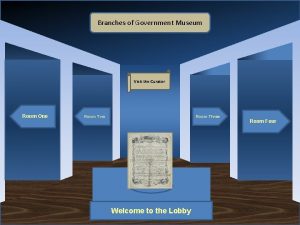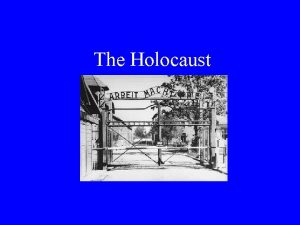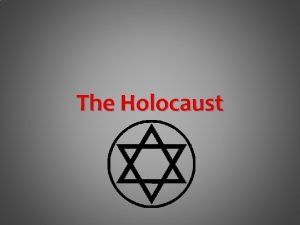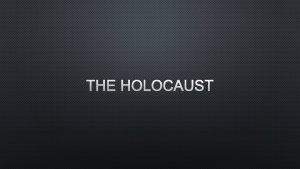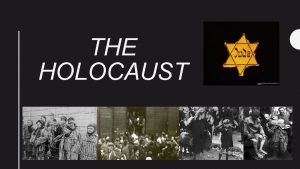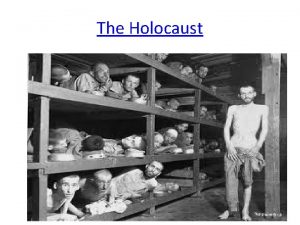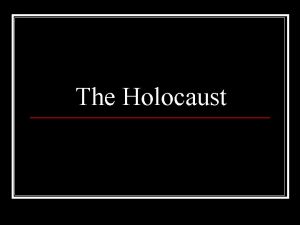Holocaust Museum Visit the Curator where it started





















- Slides: 21

Holocaust Museum Visit the Curator where it started those who left Those who stayed Artifact 1 Museum Entrance Welcome to the Lobby liberation

Name of Museum Curator Information Created by: Mary Carlo Breanna Turner Kirstin Petersen Elementary Education majors at Bradley University Standards References Back to Lobby Note: Virtual museums were first introduced by educators at Keith Valley Middle School in Horsham, Pennsylvania. This template was designed by Lindsey Warneka under the direction of Dr. Christy Keeler during a Teaching American History grant module. View the Educational Virtual Museums website for more information on this instructional technique.

Name of Museum ers b m u n n Priso Artifact 3 railcar Artifact 4 Artifact 2 Where it began yellow s tar

Name of Museum Skirt Artifact 6 gas chamber Artifact 7 Artifact 5 Room 2 Title Hartheim Register

Name of Museum Shirt Artifact 9 Bible Artifact 10 Artifact 8 Room 3 Title Survivor

Name of Museum Boat Artifact 12 Bible Artifact 13 Artifact 11 Room 4 Title Prisoners g a rb

Name of Museum Survivors https: //www. youtube. com/watch? v=Mtx. A 5 C 74 Cfk -Survivors of the Holocaust telling their story about what they went through and how they survived. -Remembering when it first started Back to Room 1

Name of Museum Prisoner numbers Insert Artifact Picture Here https: //www. loc. gov/item/2010630443/ • Located in Boston, Massachusetts in 1995 designed by Stanley Saitowitz • In the New England holocaust memorial there are 6 different towers, the picture is one of them, visitors can walk under these towers. • On these towers there are 6 million numbers and each number represents a loved one who died in the Holocaust. There also random messages engraved on these towers. • As you walk under the towers steam rises up through metal grates from a dark floor with twinkling lights on it. Back to Room 1

Name of Museum Railcar https: //www. ushmm. org/wlc/en/media_da. php? Media. Id=8442 • This is an interior of a railway car used for the deportation of Jews. • Jews were told by going on this railway car they were being brought to labor camp, in 1941, but in reality they were going to killing centers in Poland. • The original rail car is on display in the United States Holocaust memorial museum permanent exhibition. Back to Room 1

Name of Museum Yellow Star http: //www. yadvashem. org/yv/en/education/artifacts/star. asp • This star is what the Bulgarian Jews were forced to wear in 1941. This star was worn by David Button. • They were order to wear their star on their lapel and this helped the Germans set apart Jews from other citizens. • Wearing this star meant they had certain restriction put upon them one including they could only leave their houses for 2 hours a day. Back to Room 1

Name of Museum Hana’s Camp Skirt https: //www. ushmm. org/wlc/en/media_da. php? Media. Id=120 • This artifact was a girls skirt that was given to her in the concentration camps. The limited clothing provided made her use hemming to make pockets on her skirt. • women were very vulnerable • Women would create groups which survived through sharing information, food and clothing. • SS Camp authorities would deploy them clothing repair, cooking, laundry and housecleaning detachments. Back to Room 2

Name of Museum Gas Chamber door https: //www. ushmm. org/wlc/en/media_da. php? Media. Id=97 • This was located in Majdanek killing center, near Lublin, Poland. Majdanek functioned as a concentration camp, forced-labor and killing center. Research has indicated that the SS deported between 74, 000 and 90, 000 Jews to the Majdanek main camp. • Each chamber was fitted with an airtight metal door. These were bolted shut before gas entered the chamber inside • SS guards could observe the killing process through peepholes in the upper center of the door. • If Germans decided that the Jews were unable to work they were put in these chambers. Back to Room 2

Name of Museum Hartheim Register Expand Toolbar https: //www. ushmm. org/wlc/en/media_da. php? Media. Id=8868 • This was a document used to calculate the number of deaths in the Nazi program • This was found in a locked filing cabinet by the US army troop in 1945 at a killing site. • On the right of the page details by month the number of patients who were “disinfected” in the 1940 • The last column represents that 35, 224 people had been put to death that year. Back to Room 2

Name of Museum Child’s sweater worn in hiding Insert Artifact Picture Here https: //www. ushmm. org/wlc/en/media_da. php? Media. Id=8866 When the Lvov ghetto was liquidated in the year 1943, many Jews ran and escaped to the underground sewers beneath the city streets. This sweater belong to a young eight year old girl, Krystyna Chiger. Krystyna hid in the sewers with her family and 16 other people for 14 months. She wore this sweater during those 14 months of hiding. Krystyna who later changed her name to Kristine Keren, donated this sweater to the U. S. Holocaust Memorial Museum. Back to Room 3

Name of Museum Bible from pastor Insert Artifact Picture Here https: //www. ushmm. org/wlc/en/media_da. php? Media. Id=100 A Protestant pastor, Andre Trocme, had his family Bible that he used to prepare and annotate his sermons. He was a pastor in Le Chambon-sur-Lignon, France. He was known for helping shield the Jews from the Germans—especially Jewish children. His operation that many town residents helped with saved around 5, 000 refugees including many Jews. One of his handwritten inscriptions in French that can be found in his Bible reads, in part, "Happy are those hungry and thirsty of justice; for they will be satisfied. " This particular artifact can be found at the U. S. Holocaust Memorial Museum. Back to Room 3

Name of Museum Holocaust survivor Insert Artifact Picture Here http: //thechronicleherald. ca/artslife/1163002 -holocaust-survivor-shares-story-of-his-escape-from-death-pit A Holocaust survivor named Michael Kutz, as a 10 year old boy watched his mother, siblings and 4, 000 others die in the Nazi death pits, but young Michael escaped. Before his mother died she said “if, by miracle, you survive, ” she’d said before they were separated, before she kissed him for the last time, “you must bear witness. ” After he escaped he went to Halifax as a war orphan, and later became a resistance fighter. As of three years ago he was an 82 year old Holocaust survivor you has written a memoir to share his story. If you want to hear more about Kutz’s story read his memoir If, By Miracle. Back to Room 3

Name of Museum Danish Rescue Boat Insert Artifact Picture Here https: //www. ushmm. org/wlc/en/media_da. php? Media. Id=99 • This boat named was named sunshine • It was used in world war two transport Danish refugees from Denmark to Sweden • Throughout Denmark many people just stood by and did not help the Jews, so this boat is an important example of the few that did go out of there way to help the Jewish community. • The Danish rescue force was unique because it was nationwide, however not every mission to transport the Jewish Citizens was not successful. Back to Room 2

Name of Museum Bible Found at Liberation Insert Artifact Picture Here https: //www. ushmm. org/wlc/en/media_da. php? Media. Id=104 • Soviet forces liberated the Sachsenhausen concentration camp in April 1945 • In this camp Soviet soldiers found this German edition of the old and new testaments on a dead prisoner, a Jehovah’s Witness • The bible was sent to the prisoners surviving family • Soviet soldiers were some of the first to liberate concentration camp prisoners in the final stages of war. • Many the Germans had been forced to leave these camps and prisoners behind in their hasty retreat from the camp. Back to Room 2

Name of Museum Prisoner’s Garb from Auschwitz http: //www. yadvashem. org/yv/en/museum/artifacts/prison_garb. asp • This is the prisoner garb that Walter Loebner was given when he was in Auschwitz • Before Walter was put in the concentration camp he was a surgeon in Marienbad • Walter was able to escape from Auschwitz on April first and was able to hide away in a forest until he was liberated by the Red Army • After he was liberated he returned to practicing medicine near Oranienburg • He was married after the war and was able to have a happy healthy family Back to Room 2

Name of Museum 16. A. 3 b Make inferences about historical events and eras using historical maps and other historical sources 16. A. 4 b Compare completing historical interpretations of an event D 2. His. 4. 3 -5. Explain why individuals and groups during the same historical period differed in their perspectives D 2. His. 9. 3 -5. Summarize how different kinds of historical sources are used to explain events in the past Back

Name of Museum References https: //www. loc. gov/item/2010630443/ http: //www. yadvashem. org/yv/en/education/artifacts/star. asp https: //www. ushmm. org/wlc/en/media_da. php? Media. Id=120 http: //thechronicleherald. ca/artslife/1163002 -holocaust-survivorshares-story-of-his-escape-from-death-pit Back
 Curator room
Curator room Digital curator
Digital curator Curator opleiding
Curator opleiding Art lovers can visit the - metropolitan museum of art.
Art lovers can visit the - metropolitan museum of art. A visit to the liberation war museum
A visit to the liberation war museum Holocaust scavenger hunt
Holocaust scavenger hunt Holocaust
Holocaust Butterfly project examples
Butterfly project examples Easy weather acrostic poem
Easy weather acrostic poem David bergman holocaust
David bergman holocaust Holocaust
Holocaust Holocaust dbq
Holocaust dbq Martin niemoller poem
Martin niemoller poem Disaster acrostic poem
Disaster acrostic poem Acrostic poem for decolonization
Acrostic poem for decolonization Chapter 16 section 3 the holocaust answer key
Chapter 16 section 3 the holocaust answer key Holocaust
Holocaust Totalitarianism
Totalitarianism Guidelines for teaching about the holocaust
Guidelines for teaching about the holocaust Holocaust acrostic poem examples
Holocaust acrostic poem examples Holocaust hungary
Holocaust hungary Upstanders and bystanders during the holocaust
Upstanders and bystanders during the holocaust

